Creating To-Do Lists In WordPress
 If you are running a growing business or managing a team, there never seems to be enough time to get things done.
If you are running a growing business or managing a team, there never seems to be enough time to get things done.
There is just so much work to do and things to remember. You have clients to meet, tasks to complete, priorities to attend to, fires to put out, calls and appointments to make, schedules to keep and so on. The stress of trying to get things done on time never seems to end.
Now … add the extra workload of trying to promote and grow your business online and maintaining your website updated with new content and everything suddenly begins feeling unmanageable and chaotic.
Whether you run a business, website, blog, or manage a project, it’s important to be able to organize and prioritize your daily activities, track your progress and daily accomplishments, and, if necessary, assign tasks and responsibilities to others effectively.
One simple proven method that can help you save time, create a sense of order and manageability, and allow you to regain control is to use a “to-do” list.
The Benefits Of Using To Do Lists
A “to-do” list can help you track your progress as you work to achieve specific objectives. Your to do list can be detailed or specific, or just serve as a concise reminder of what needs to be done today, tomorrow, this week, this month, etc.
Here are just some of the many benefits of using to-do lists:
Stay Organized
Having a to do list helps you create order, stay organized and reach your goals faster.
Strategize
Creating and organizing to do lists helps you see the larger picture and create a strategic plan to get things completed on time and on budget.
Reorganize Or Reschedule Quickly
A to do list helps you better handle new and unexpected situations. If you find that a meeting gets cancelled or extra time has been made available because something got completed sooner than expected, you can keep working without loss of focus.
Less Stress
Stress can come from feeling overwhelmed by the fact that there is so much that needs to get done and so very little time to do it all in. Creating a to-do list allows you to work on important items that have to be completed within a reasonable timeframe, and push out tasks that can be addressed later. This can help reduce stress.
Collaborating With Others
Creating to-do lists and other project management tools is essential for getting other people involved on some of your larger or more complex projects.
As you can see, there are many benefits to using a to do list, both in business and in your personal life. Create a list, prioritize your list items and work in a focused manner and productivity and efficiency in your business is sure to increase.
What about using a to-do list on your website or blog?
In this detailed tutorial you are going to learn how to easily add to do lists to a WordPress site to improve business efficiency and productivity using a great little plugin called Cleverness To-Do List.
Cleverness To-Do List
Download The Cleverness To-Do List Plugin
http://wordpress.org/plugins/cleverness-to-do-list/
Description
This WordPress plugin provides users with a to do list feature.
Cleverness To-Do List Plugin Features
Note: the features listed below are discussed in more detail in the tutorial section.
You can set up Cleverness To Do List with private to do lists for individual users, to have all users share your to-do list, or to have a master list with individual item completions.
The shared to do list option has a variety of settings available. You can delegate to-do items to a specific user (this includes a setting to email a new to-do item to the assigned user) and optionally to have assigned items be viewable by that user. You can also assign different permission levels to different users based on user roles. There are also settings available to show deadline and progress fields. Category support is also included as front-end administration.
A new menu item is added to the backend to help you manage your list and your to do lists can also be displayed on a dashboard widget.
A sidebar widget is also available as short code to display the to-do list items on your site. There are 2 short codes for front-end administration of your list. Management of categories is restricted to the back-end.
If you plan to run a multi-author blog you can use the to do lists plugin to create custom to do lists for your post editors if you also use a copy of the developer’s premium plugin, Post Planner.
Installing The Plugin
From your WordPress admin area, select Plugins > Add New …
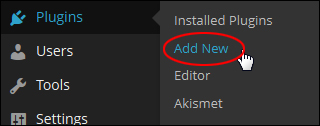
In the Install Plugins screen, type in “cleverness” into the search field and click Enter …
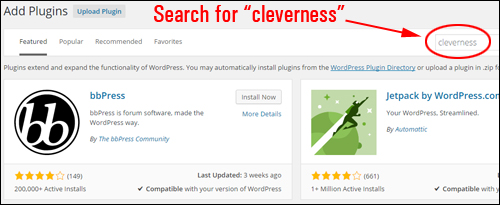
Locate the plugin in the Search Results area and click Install Now …

Activate the plugin after installing it …

Note: You can also activate this plugin in the Plugins screen …

After the plugin has been activated, click on Settings …

Note: The ‘Settings’ section can also be accessed by choosing To-Do List > Settings from your dashboard menu …

This takes you to the plugin ‘Settings’ section …

The section below shows you how to go through the plugin setup process …
Setting Up The Cleverness To-Do List Plugin
The plugin’s ‘Settings’ area is divided into 4 sections:
- To-Do List Settings – The options in this section let you specify the main plugin settings.
- Advanced Settings – In this area you can customize your To-Do lists, assign to-do items to other users and perform plugin database maintenance tasks.
- User Permissions – In this tab you can set up user permissions and capabilities for Master and Group List types.
- Import/Export – This area is where you can import and export to-do plugin and list data settings.
Let’s configure each of these tabs.
To-Do List Settings
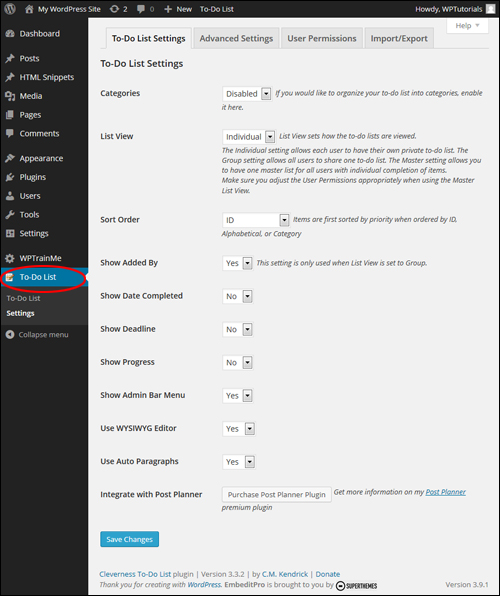
To-Do List Categories
Choose ‘Enabled’ to organize your to-do lists into categories, otherwise leave this option set to ‘Disabled’.
Note: If you enable this option, a ‘Categories’ item gets added to the To-Do List menu …
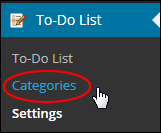
This lets you add categories that you can use to organize your to-do lists (see ‘Plugin Usage’ section further below for more details) …
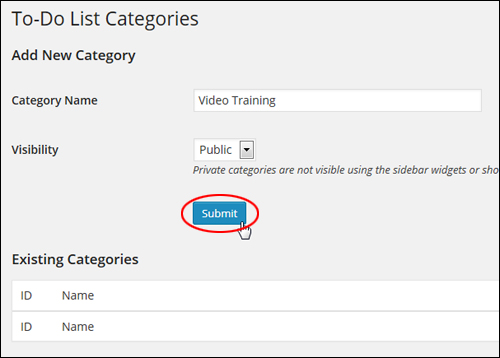
You can set up ‘public’ and ‘private’ categories for your to-do lists.
Categories set to ‘private’ will not be visible using widgets or shortcodes (only when ‘Sort Order’ is set to ‘Category’)
List View
List View lets you specify how your lists are viewed. You can select three types of list views:
- Individual – Choosing this option allows each user to create and manage their own private to-do list.
- Group – Selecting this option lets all users share one to-do list.
- Master – Select this option to have one master list for all users, where users have their own individual items to complete. If using the ‘Master’ list view, make sure that you configure the User Permissions appropriately in the ‘User Permissions’ tab (this is covered further below).
Sort Order

‘Sort Order’ lets you specify how list items will be sorted.
If you choose ID, Alphabetical, or Category options, items will be first sorted by priority.
Show Added By
Enabling this option (‘Yes’) lets you display which users on your site have added an item to the to-do list.
Note: This setting only works when ‘List View’ is set to ‘Group’.
Show Date Completed
Enabling this option displays completion dates for your to-do items.
Show Deadline
Enabling this option (‘Yes’) lets you specify deadlines for to-do items …

Show Progress
Enabling this option (‘Yes’) lets you specify task progress indicators for your to-do items …

Show Admin Bar Menu
If this option is enabled (‘Yes’), the ‘To-Do List’ menu will display in your WordPress Admin bar …

Use WYSIWYG Editor
This option lets you add and edit items on your to-do list using the WordPress WYSIWYG Editor …

Use Auto Paragraphs
Enable this option to display content in to-do lists using paragraphs.
Integrate with Post Planner
If you are running a multi-author site or blog, you can integrate the Cleverness To-Do List plugin with a plugin called WordPress Post Planner, from the same developer that provides you with a complete WordPress editorial solution …
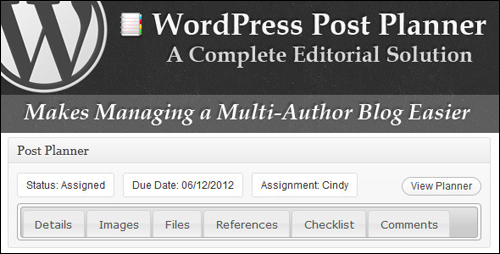
Go here to learn more about using this plugin: WordPress Post Planner – Plugin For WordPress
After configuring your plugin options in this section, remember to click the ‘Save Changes’ button …

Advanced Settings
After configuring the general settings, click on the ‘Advanced Settings’ tab to proceed …

This brings you to the ‘Advanced Settings’ screen …
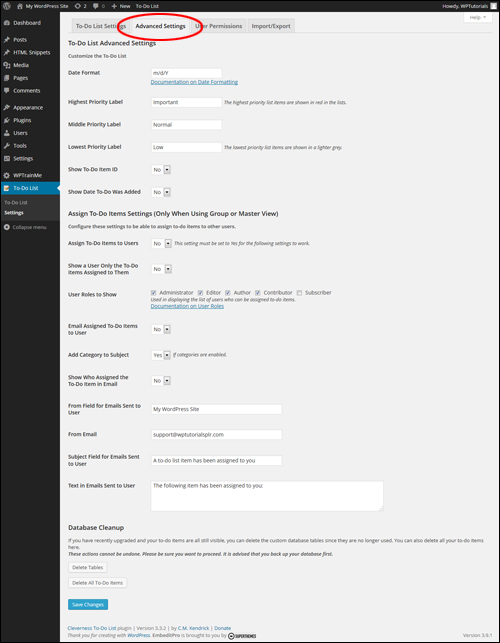
In this tab you can customize your To-Do lists, assign to-do tasks to users and perform database maintenance tasks.
Let’s take you through how to configure the plugin’s ‘Advanced Settings’ section …
To-Do List Advanced Settings > Customize The To-Do List
This section of the ‘Advanced Settings’ tab allows you to customize your To-Do List …
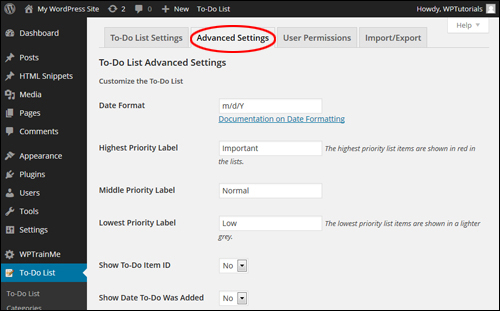
You can configure the following options in this section:
Date Format
This section lets you specify how to display dates on your todo lists (e.g. month/day/year, day/month/year, etc.)
Note: To learn more about how to format dates in WordPress, see the date section of the WordPress Codex below:
WordPress Codex – Formatting Date And Time
Priority Labels
Here you can customize your labels for highest (important), normal and lowest (low) priority items …

Items given the highest priority are colour-coded in red in the lists and lowest (low) priority items display in a lighter shade of grey …

Show To-Do Item ID
If enabled, item IDs will show on your to-do list …
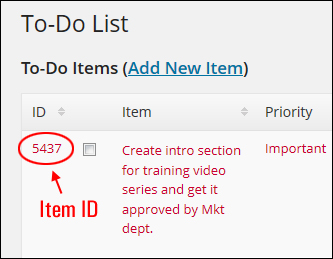
Show Date To-Do Was Added
Enabling this option (‘Yes’) will display the date your items table was added …
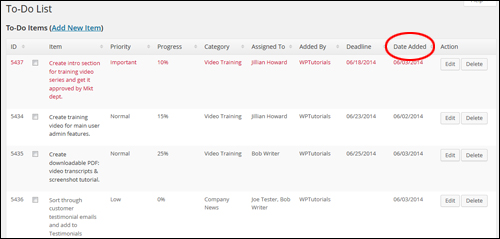
To-Do List Advanced Settings > Assign To-Do Items Settings
If you have chosen ‘Group’ or ‘Master’ View for your to-do list, you can configure the options in this section and assign to-do items to other users …
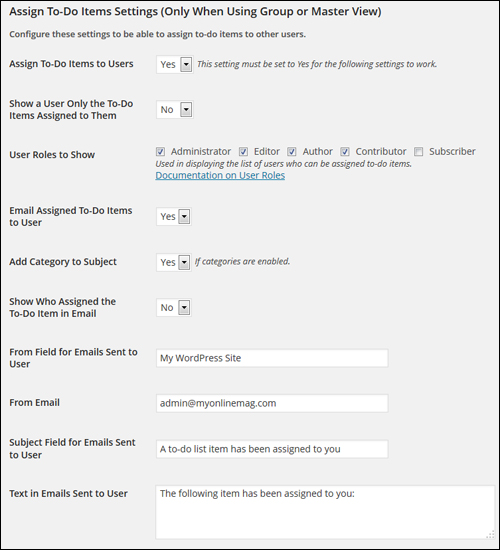
You can configure the following options in this area:
Assign To-Do Items to Users
Enable this option (‘Yes’) to assign tasks to other users …

Note: This set this option to ‘Yes’ for the settings below it to work.
Show a User Only the To-Do Items Assigned to Them
Enable this option (‘Yes’) to display to-do items only to users who have been specifically assigned those items. Leave this option disabled (‘No’) to display items to all users.
User Roles to Show
Checking the boxes in this area Editor displays the type of users that can be assigned todo items. Leave the checkbox unticked for any roles that you don’t want to assign to-do items.
Email Assigned To-Do Items to User
If you enable this option, WordPress automatically sends an email to users with their assigned to-do items …

Leave this option disabled if you don’t want to send out emails to users.
Note: If you disable this option, skip other settings in this section.
Add Category to Subject
If you have enabled categories in your plugin settings and select ‘Yes’ for this option, the to-do category will display in the subject of emails sent to users …

Leave this option disabled (‘No’) if you don’t want to-do categories to show the subject of your emails.
Leave this option disabled (‘No’) if you don’t want categories to appear the email subject.
Show Who Assigned the To-Do Item in Email
Enable this option (‘Yes’) to display the user who assigned the to-do item in the email. This option is useful if, for example, your site has several project managers assigning to-do items to users …

From Field for Emails Sent to User
This field allows you to customize the “From” field when sending out emails. Add your company name, your domain, your name, or anything you like in this field …

From Email
Add the email address that you would like showing as the “sent from” email address …

Subject Field for Emails Sent to User
In this field, type a subject field for the email that will be automatically sent to users when new items have been assigned to your to-do list …

Text in Emails Sent to User
Add into this field the body of the email message that will be sent out automatically to users when a new item has been assigned to your to-do list.

To-Do List Advanced Settings > Database Cleanup
This section lets you perform database maintenance operations related to plugin data directly from the plugin settings area itself …

This function is useful if, for example, you see that old to-do items are still showing on your site.
You can perform the following tasks:
- Delete Tables – Remove any custom database tables that you are no longer using.
- Delete All To-Do Items – Delete all of your to-do items.
![]()
Any actions that you perform on your database from this screen cannot be reversed. If you are comfortable to proceed with any of the database operations available in this section, then we recommend backing up your WP database first.
If you don’t want to perform your own backups, then consider using professional WordPress help services, or use backup plugins. You can read about a great WordPress backup plugin that we recommend using to automate WordPress file and database backups here:
User Permissions
This section lets you configure user permissions and capabilities for Group or Master List types …

![]()
If you have chosen Individual List, the only item that applies in this section is the View To-Do List permission …

If you are configuring user permissions and capabilities for Group and Master List types, select the highest level capabilities that you would like users to be able to perform for each option …
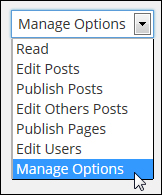
By default, general capabilities for each user role are set up as follows:
- Subscribers: Read
- Contributors: Edit Posts
- Authors: Publish Posts
- Editors: Edit Others Posts
- Administrators: Manage Options
Note: When using the Master list type non-administrators should only be allowed to view and complete items, otherwise they will have the ability to edit the Master list itself.
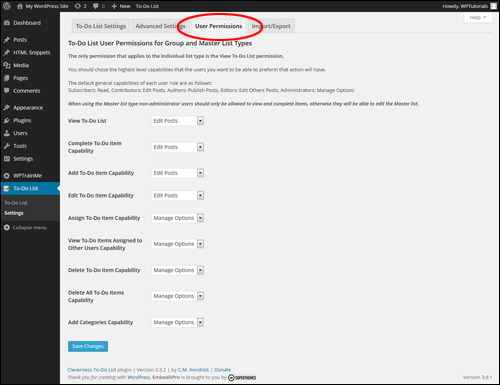
Let’s review the settings for the User Permissions section:
View To-Do List
This option permits the selected capability to view to-do items in the dashboard widget and on the To-Do List page under the ‘Tools’ section.
Complete To-Do Item Capability
Here you can allow the chosen capability to mark items as completed or uncompleted.
Add To-Do Item Capability
This setting enables the selected capability to add new to-do items.
Edit To-Do Item Capability
This option allows the chosen capability to modify existing to-do items.
Assign To-Do Item Capability
Here you can enable the chosen capability to assign items to individual users.
View All Assigned Tasks Capability
Here you can enable the chosen capability to view all tasks even if “Show Each User Only Their Assigned Tasks” is set to ‘Yes’.
Delete To-Do Item Capability
This option permits the selected capability to delete individual items.
Delete All To-Do Items Capability
This option allows the selected capability to purge all the completed items.
Add Categories Capability
Here you can enable the chosen capability to add new categories.
Import/Export
The ability to import and export to-do list data can be very useful. For example, you may decide to transfer data from an existing list to another website, or export the data for backup or archiving purposes.
To access this function, click on the ‘Import/Export’ tab in your plugin settings area …

Use this section to easily export or import your list and plugin settings …
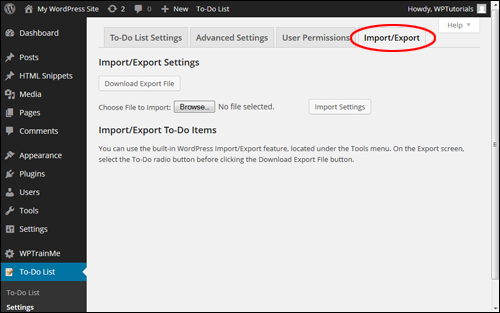
Exporting To-Do List Data
To export and download your to-do list data settings click on the ‘Download Export File’ …

This opens up a window allowing you to view or save the data in a plain text file (e.g. Notepad) to a storage device (e.g. your hard drive) …

In addition to exporting list data from the ‘Import/Export’ section, you can also export data by going to your WordPress dashboard menu and choosing Tools > Export …
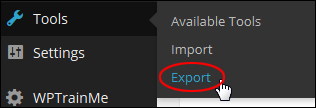
You can include to-do list data in a WordPress export file (in XML format), either by selecting ‘All content’ (includes everything – pages, posts, etc…), or just select ‘To-Do’ from the ‘Choose what to export’ section and click the ‘Download Export File’ button to download your file to an internal or external hard drive…

Importing To-Do List Data
Importing a previously saved to-do list data file is easy. Just click on the ‘Browse’ button next to the ‘Choose File to Import’ field …

Select the previously saved to-do list data file in your hard drive or external drive and click ‘Open’ …
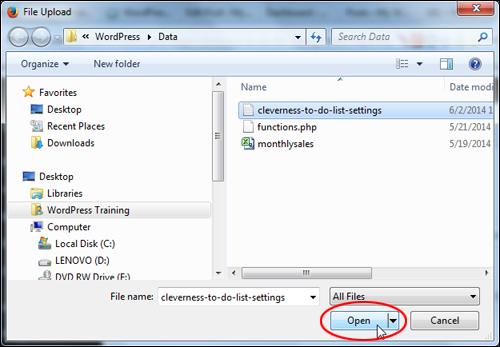
Once uploading your data file, click the ‘Import Settings’ button …

Your file will be imported.
After configuring all of the plugin settings, you are ready to begin create and edit to do lists.
Plugin Usage
To create a new to-do list, go to your WordPress admin menu and select To-Do List > To-Do List …
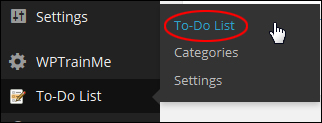
This brings up the ‘To-Do List’ page …
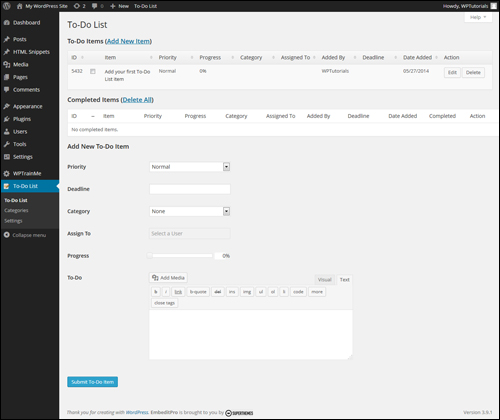
Add New To-Do Items
There are a number of ways to add new to-do items.
For example, you can add new items to your to-do list from your dashboard toolbar …

You can also add new to-do items inside your Dashboard by clicking on the ‘Add To-Do item’ link …
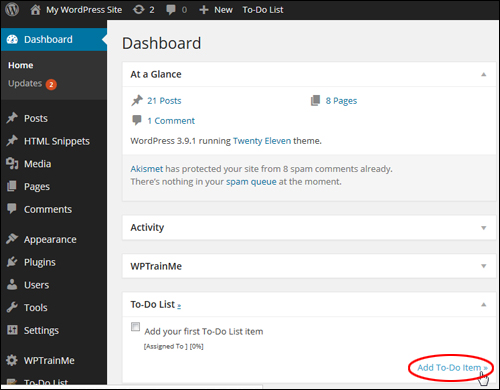
You can click on the ‘Add New Item’ link in the ‘To-Do Items’ section (note: only use this option if your To Do list contains many items, as the link will simply send you to the “Add New To-Do Item” section at the bottom of the screen) …

All the methods shown above will bring you to the ‘Add New To-Do Item’ area.
Depending on the way you have configured the plugin’s settings, you may or may not see certain options displayed when new items to your to-do list.
Set up the options you have enabled for your to-do items, enter appropriate information into the relevant fields and click on the ‘Submit To-Do Item’ button to add the to-do item …
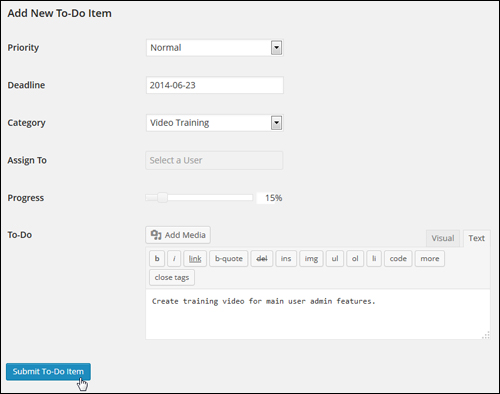
Note: If you have selected a list type that lets you assign tasks to users, select a user from the drop-down list and assign them the item …
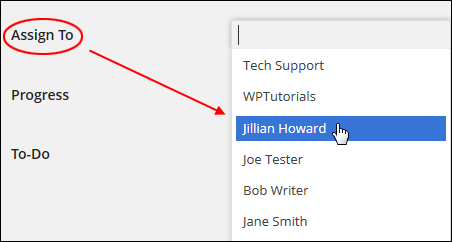
You can also make multiple users responsible for the same item (click on ‘x’ to delete users) …

Once you have added the item, it will display as an entry in the ‘To-Do Items’ table …

Repeat this process to keep adding items to your to-do list …
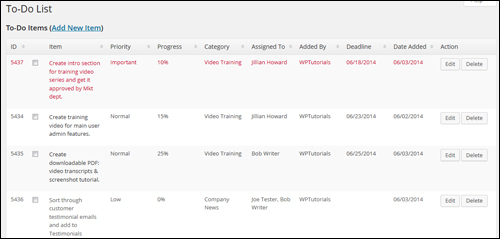
Edit And Delete To Do Items From Your List
To edit or delete an item, click on the ‘Edit’ or ‘Delete’ buttons associated with each item under the ‘Action’ column …

Depending on how you have configured your plugin settings (see previous section), users assigned to completing tasks may also receive email notifications …
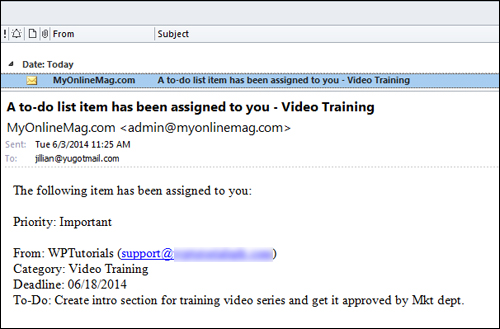
Once you have created your to do list, users can view it when logged into their own user dashboard …
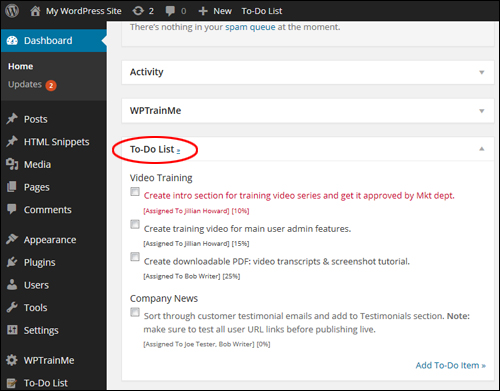
When users assigned with completing an item click on the item check box …
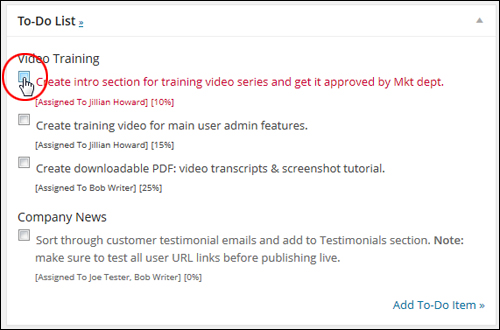
… the item is then deleted from the “To-Do” list …
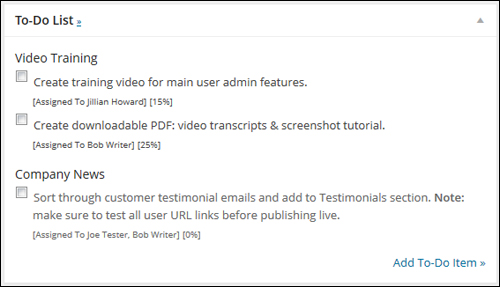
And gets added to the ‘Completed Items’ section located in the ’To-Do List’ screen …

Additional Plugin Information
The Cleverness plugin provides additional functions that let you display a to-do list on your site using widgets, and display a list on any page or post using shortcodes.
Plugin Widget
To add to-do lists to your site using widgets, go to the ‘Widgets’ section (Appearance > Widgets) and drag the ‘To-Do List’ widget to the menu location where you want the to-do list to appear …

Configure the widget settings and click ’Save’ to update your settings …
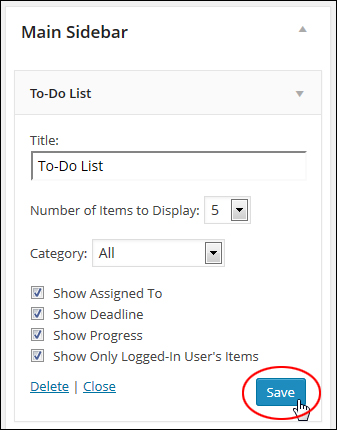
Your list will display wherever the widget was placed (i.e. the sidebar menu, footer, etc.)
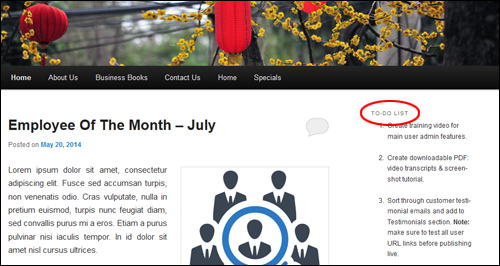
To learn more about using widgets in WordPress, see the tutorial below:
Using Plugin Short Codes
Cleverness To-Do List also lets you create to-do lists and checklists to your site by inserting short codes into your content.
To access the plugin’s shortcode documentation, select To-Do List > To-Do List from your WP admin menu …
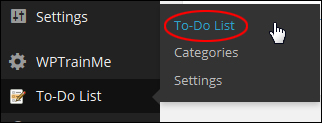
Click on the ‘Help’ tab on the corner of your screen …
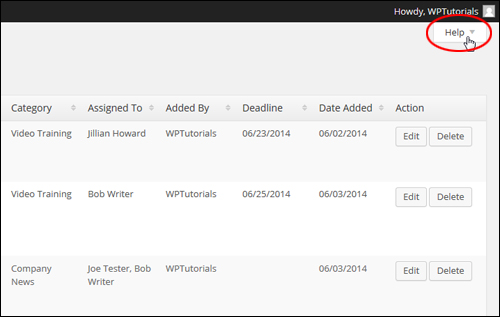
Click on the ‘Shortcodes’ tab to access the Shortcode Documentation …

This section explains various ways to configure and use short codes to display lists and checklists on your posts and pages.
Once you know what information you want to display on your site, create a new post or page and either type or paste the shortcode into the content section …
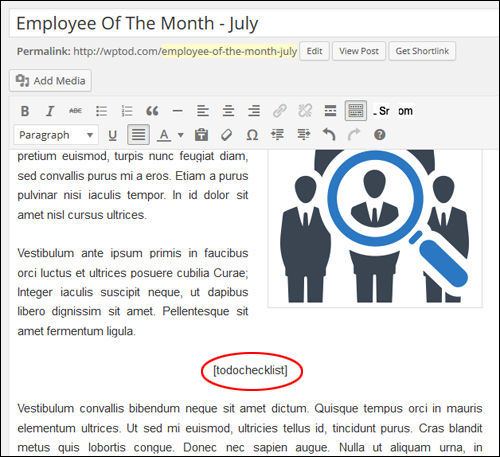
After publishing your page or post, you should see the list displayed in the location where you added the shortcode …
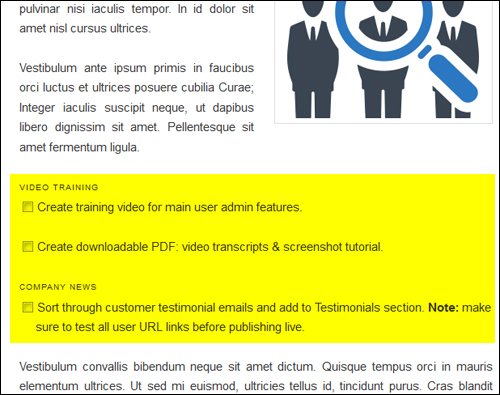
Visit this site for more information about this plugin:
Congratulations! Now you can add a to-do list to your WordPress site.
***
"This is an awesome training series. I have a pretty good understanding of WordPress already, but this is helping me to move somewhere from intermediate to advanced user!" - Kim Lednum
***
